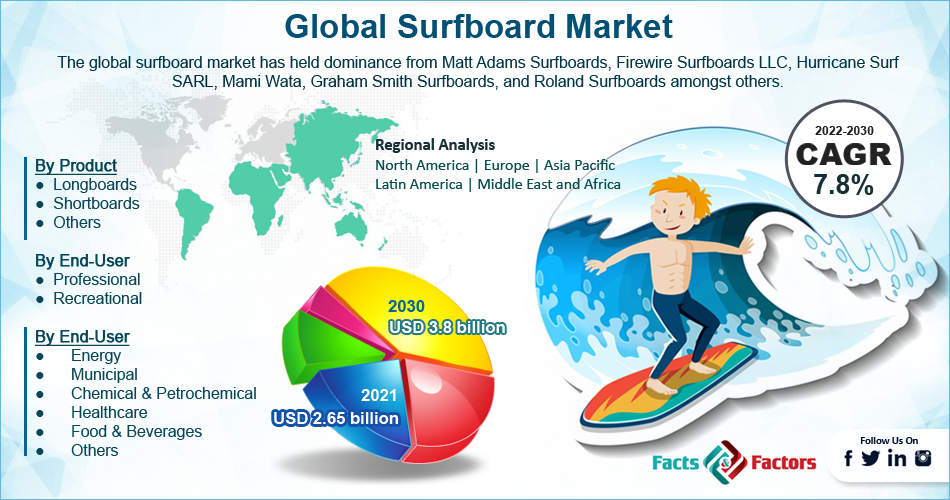Search Market Research Report
Surfboard Market Size, Share Global Analysis Report, 2022 – 2030

Surfboard Market Size, Share, Growth Analysis Report By Distribution Channel (Hypermarkets & Supermarkets, Specialty Stores, Online Retail, and Others), By Product (Longboards, Shortboards, and Others), By End-User (Professional and Recreational), and By Region - Global and Regional Industry Insights, Overview, Comprehensive Analysis, Trends, Statistical Research, Market Intelligence, Historical Data and Forecast 2022 – 2030
Industry Insights
[215+ Pages Report] According to the report published by Facts and Factors, the global surfboard market size was worth around USD 2.65 billion in 2021 and is predicted to grow to around USD 3.8 billion by 2030 with a compound annual growth rate (CAGR) of roughly 7.8% between 2022 and 2030. The report analyzes the global surfboard market drivers, restraints/challenges, and the effect they have on the demands during the projection period. In addition, the report explores emerging opportunities in the surfboard market.

 Market Overview
Market Overview
The surfboard is the main equipment used in one of the popular forms of water sports called surfing. The structure looks like a narrow plank and is lightweight which means that users can carry it in one hand. The lightweight also allows for it to provide enough support to the person standing on it while reading an oceanic wave. Surfboards were invested in Hawaii and were popularly known as he'e nalu which depicts the Hawaiian language. Older generation surfboards were made from the wood of the locally found trees, with the koa being the main raw material, and weighed extremely heavily while standing at 15 feet.
With the growing popularity of surfing and the eventual high demand for surfboards, modern-day planks come with one or more fins also called skegs that can help the navigator find direction stability along with other changes in the shape and materials used to manufacture surfboards. Modern planks are created using polystyrene or polyurethane. Fiberglass cloth is layered at the top alongside epoxy resin or polyester. This helps in creating a strong yet light surfboard that can be easily maneuvered. The shape of the current surfboards seen across the globe was first invented in 1937 by a teenager. The older boards were like a plank making them difficult to control. The teenager just cut a V shape at the front of the board thus giving rise to the modern age surfboards.
 Key Insights
Key Insights
- As per the analysis shared by our research analyst, the global surfboard market is estimated to grow annually at a CAGR of around 7.8% over the forecast period (2022-2030)
- In terms of revenue, the global surfboard market size was valued at around USD 2.65 billion in 2021 and is projected to reach USD 3.8 billion, by 2030.
- The market is projected to grow at a significant rate due to the growing interest in surfing activity
- Based on distribution channel segmentation, specialty stores were predicted to show maximum market share in the year 2021
- Based on end-user segmentation, the amateur was the leading user in 2021
- On the basis of region, North America was the leading revenue generator in 2021

 Growth Drivers
Growth Drivers
- Growing interest in surfing to propel market demand
The global surfboard market is projected to grow owing to the growing popularity of surfing, a highly intense water sport or activity. It takes place at the surface of the water and generally involves one person on top of the surfboard trying to ride a moving wave along with it and reach the shore. It can also be done on standing waves in lakes, rivers, or in wave pools. The water recreational activity has roots in countries surrounded by large expanses of water mainly located in regions like Peru, California, and Polynesia, because one important point to note is that surfing cannot be done on all waters. Surf waves, also known as swell, are the ideal choice of waves for surfers. Like many other activities, surfing, even though initially restricted to only certain countries, has managed to expand its presence in other countries as well where people may either take it up for recreational purposes to train to become professional surfers. As per the recent data submitted by the International Surfing Association (ISA), the body that governs the surfing sector worldwide, more than 35 million people surf on a regular basis.
 Restraints
Restraints
- Risks associated with surfing to restrict market expansion
The global market is projected to face growth restrictions owing to the various dangers and risks associated with surfing. All water activities are regarded as high in risk but the index in terms of surfing is even higher. Since the activity involves one person without the assistance of any form of technology trying to ride a wave. Water waves are extremely unpredictable and a normal-looking wave can turn dangerous in no time. An average of 10 deaths are reported every year in the surfing sector. This number does not include the injuries associated with surfing. The problem does not really have a solution but if proper precautions are taken, mishaps can be avoided.
 Opportunities
Opportunities
- Increasing tourism to provide growth opportunities
The global surfboard market players are anticipated to benefit from the growing travel and tourism industry, especially near islands. Most of the surfing agencies recorded a high number of bookings as the global economy has steadily opened up for tourism. Post-pandemic Maldives, one of the world’s most famous water-covered tourist destinations, recorded more than 1.29 million tourists in 2021. Almost all the tourists visiting the country try the highly recommended surfing in steady water in the Maldives. Australia is most famous for its surfers and the country earned around USD 34 billion in 2021-2022 from tourism.
 Challenges
Challenges
- Presence of low-quality surfboards to challenge the market expansion
The global market faces many challenges, the main one being the presence of low-quality surfboard manufacturers. It is always recommended to purchase surfboards from legal and authorized sellers as a defect in the surfboard can be fatal for the surfer. Controlling the circulation of counterfeit, low-grade products in the global market is a key factor that greatly influences revenue generation.
 Segmentation Analysis
Segmentation Analysis
The global surfboard market is segmented based on distribution channel, product, end-user, and region
Based on distribution channel the global market segments are hypermarkets & supermarkets, specialty stores, online retail, and others. In 2021, the global market witnessed the highest growth in the specialty stores segment. Since surfboards are extremely personal objects as a single board is assigned to an individual surfer, generally, people tend to customize the boards as per their personalities and end-goal which is why specialty stores are the most preferred choice. A custom-made board can cost above USD 600. The most expensive one is the Pete Peterson 1949 California Point Break Board which was sold for USD 32,400 in 2013.
Based on end-user, the global market divisions are professional and recreation. The latter generated the highest revenue in 2021 due to the recent interest of amateur surfers in water sports. The beginners undergo training for multiple months before they can compete on a professional level. The basics of surfing can be learned in 3 sessions but mastering the sport is a life-long activity
 Recent Developments:
Recent Developments:
- In October 2022, the Chinese government conducted major military drills to prepare itself for a future war with Taiwan. The country tested jet-propelled surfboards to strengthen its assault impact
- In February 2022, Awake, a pioneer in surfboards, announced the launch of a new range of electric surfboards called Ravik S 22
 Report Scope
Report Scope
Report Attribute |
Details |
Market Size in 2021 |
USD 2.65 Billion |
Projected Market Size in 2030 |
USD 3.8 Billion |
CAGR Growth Rate |
7.8% CAGR |
Base Year |
2021 |
Forecast Years |
2022-2030 |
Key Market Players |
Matt Adams Surfboards, Firewire Surfboards LLC, Hurricane Surf SARL, Mami Wata, Graham Smith Surfboards, Roland Surfboards, and others. |
Key Segment |
By Distribution Channel, Product, End-User, and Region |
Major Regions Covered |
North America, Europe, Asia Pacific, Latin America, and the Middle East &, Africa |
Purchase Options |
Request customized purchase options to meet your research needs. Explore purchase options |
 Regional Analysis
Regional Analysis
- North America to witness the highest growth during the projection period
The global surfboard market is projected to be dominated by North America in the coming years owing to the dominance of the US in the production and use of surfboards. The plank first originated in Hawaii, a US state, and spread from there. Currently, the US has more than 2.86 million surfers out of which the majority are highly experienced in sports and compete at international competitions.
The increasing development in the manufacturing of different types of surfboards may further help generate more revenues in the regional market alongside growing tourism in the country allowing people from across the world to get exposure to the country’s rich surfing culture. The youth of the US accounts for more than 31.9% of the surfers present in the region.
 Competitive Analysis
Competitive Analysis
- Matt Adams Surfboards
- Firewire Surfboards LLC
- Hurricane Surf SARL
- Mami Wata
- Graham Smith Surfboards
- Roland Surfboards
The global surfboard market is segmented as follows:
 By Distribution Channel Segment Analysis
By Distribution Channel Segment Analysis
- Hypermarkets & Supermarkets
- Specialty Stores
- Online Retail
- Others
 By Product Segment Analysis
By Product Segment Analysis
- Longboards
- Shortboards
- Others
 By End-User Segment Analysis
By End-User Segment Analysis
- Professional
- Recreational
 By Regional Segment Analysis
By Regional Segment Analysis
- North America
- The U.S.
- Canada
- Mexico
- Europe
- France
- The UK
- Spain
- Germany
- Italy
- Nordic Countries
- Denmark
- Sweden
- Norway
- Benelux Union
- Belgium
- The Netherlands
- Luxembourg
- Rest of Europe
- Asia Pacific
- China
- Japan
- India
- Australia
- South Korea
- Southeast Asia
- Indonesia
- Thailand
- Malaysia
- Singapore
- Rest of Southeast Asia
- Rest of Asia Pacific
- The Middle East & Africa
- Saudi Arabia
- UAE
- Egypt
- South Africa
- Rest of the Middle East & Africa
- Latin America
- Brazil
- Argentina
- Rest of Latin America
Industry Major Market Players
- Matt Adams Surfboards
- Firewire Surfboards LLC
- Hurricane Surf SARL
- Mami Wata
- Graham Smith Surfboards
- Roland Surfboards
Frequently Asked Questions

Copyright © 2024 - 2025, All Rights Reserved, Facts and Factors


